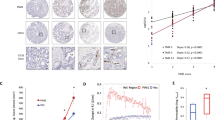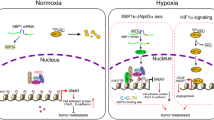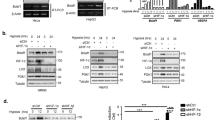Abstract
Hypoxia-inducible factor-1 alpha (HIF-1α) is the regulatory subunit of the heterodimeric transcription factor HIF-1 and the key factor in cellular response to low oxygen tension. Expression of HIF-1α protein is associated with poor patient survival and therapy resistance in many types of solid tumors. Insight into HIF-1α regulation in solid tumors is important for therapeutic strategies. In this study, we determined the pathophysiological relevance of HIF-1α regulation by the oncogenic phosphatidylinositol 3′-kinase (PI 3-kinase)/Akt signaling pathway. We modeled the physiology of hypoxic tumor regions by culturing carcinoma cells under low oxygen tension in the absence of serum. We observed that hypoxic induction of HIF-1α protein was decreased by serum deprivation. Overexpression of dominant-active Akt1 restored HIF-1α expression, whereas inhibition of PI 3-kinase activity reduced hypoxic HIF-1α protein levels to a similar extent as serum deprivation. Immunohistochemical analysis of 95 human breast cancers revealed that lack of Akt1 phosphorylation correlates with low HIF-1α levels. To our knowledge, this is the first reported comparison between HIF-1α expression and Akt phosphorylation in human carcinomas. We conclude that Akt activity is physiologically relevant for HIF-1α expression in breast cancer. This implies that HIF-1α function might be therapeutically targeted by inhibition of the PI 3-kinase/Akt pathway.
This is a preview of subscription content, access via your institution
Access options
Subscribe to this journal
Receive 50 print issues and online access
$259.00 per year
only $5.18 per issue
Buy this article
- Purchase on Springer Link
- Instant access to full article PDF
Prices may be subject to local taxes which are calculated during checkout



Similar content being viewed by others
References
Alessi DR, Andjelkovic M, Caudwell B, Cron P, Morrice N, Cohen P et al. (1996). Embo J 15: 6541–6551.
Alvarez-Tejado M, Alfranca A, Aragones J, Vara A, Landazuri MO, del Peso L . (2002). J Biol Chem 277: 13508–13517.
Arsham AM, Plas DR, Thompson CB, Simon MC . (2002). J Biol Chem 277: 15162–15170.
Bardos JI, Chau NM, Ashcroft M . (2004). Mol Cell Biol 24: 2905–2914.
Birner P, Schindl M, Obermair A, Plank C, Breitenecker G, Oberhuber G . (2000). Cancer Res 60: 4693–4696.
Bos R, van der Groep P, Greijer AE, Shvarts A, Meijer S, Pinedo HM et al. (2003). Cancer 97: 1573–1581.
Bos R, Zhong H, Hanrahan CF, Mommers EC, Semenza GL, Pinedo HM et al. (2001). J Natl Cancer Inst 93: 309–314.
Brugarolas JB, Vazquez F, Reddy A, Sellers WR, Kaelin Jr WG . (2003). Cancer Cell 4: 147–158.
Bruick RK, McKnight SL . (2001). Science 294: 1337–1340.
Burgering BM, Coffer PJ . (1995). Nature 376: 599–602.
Dales JP, Garcia S, Meunier-Carpentier S, Andrac-Meyer L, Haddad O, Lavaut MN et al. (2005). Int J Cancer 116: 734–739.
Epstein AC, Gleadle JM, McNeill LA, Hewitson KS, O’Rourke J, Mole DR et al. (2001). Cell 107: 43–54.
Forsythe JA, Jiang BH, Iyer NV, Agani F, Leung SW, Koos RD et al. (1996). Mol Cell Biol 16: 4604–4613.
Fukuda R, Hirota K, Fan F, Jung YD, Ellis LM, Semenza GL . (2002). J Biol Chem 277: 38205–38211.
Hay N, Sonenberg N . (2004). Genes Dev 18: 1926–1945.
Hudson CC, Liu M, Chiang GG, Otterness DM, Loomis DC, Kaper F et al. (2002). Mol Cell Biol 22: 7004–7014.
Ivan M, Kondo K, Yang H, Kim W, Valiando J, Ohh M et al. (2001). Science 292: 464–468.
Jaakkola P, Mole DR, Tian YM, Wilson MI, Gielbert J, Gaskell SJ et al. (2001). Science 292: 468–472.
Jiang BH, Jiang G, Zheng JZ, Lu Z, Hunter T, Vogt PK . (2001). Cell Growth Differ 12: 363–369.
Jiang BH, Rue E, Wang GL, Roe R, Semenza GL . (1996). J Biol Chem 271: 17771–17778.
Kirkegaard T, Witton CJ, McGlynn LM, Tovey SM, Dunne B, Lyon A et al. (2005). J Pathol 207: 139–146.
Kreisberg JI, Malik SN, Prihoda TJ, Bedolla RG, Troyer DA, Kreisberg S et al. (2004). Cancer Res 64: 5232–5236.
Laemmli UK . (1970). Nature 227: 680–685.
Levy AP, Levy NS, Wegner S, Goldberg MA . (1995). J Biol Chem 270: 13333–13340.
Maxwell PH, Wiesener MS, Chang GW, Clifford SC, Vaux EC, Cockman ME et al. (1999). Nature 399: 271–275.
Mottet D, Dumont V, Deccache Y, Demazy C, Ninane N, Raes M et al. (2003). J Biol Chem 278: 31277–31285.
Schmitz KJ, Otterbach F, Callies R, Levkau B, Holscher M, Hoffmann O et al. (2004). Mod Pathol 17: 15–21.
Semenza GL . (2003). Nat Rev Cancer 3: 721–732.
Semenza GL . (2004). Physiology (Bethesda) 19: 176–182.
Shibata T, Akiyama N, Noda M, Sasai K, Hiraoka M . (1998). Int J Radiat Oncol Biol Phys 42: 913–916.
Skinner HD, Zheng JZ, Fang J, Agani F, Jiang BH . (2004). J Biol Chem 279: 45643–45651.
Tang TT, Lasky LA . (2003). J Biol Chem 278: 30125–30135.
Treins C, Giorgetti-Peraldi S, Murdaca J, Semenza GL, Van Obberghen E . (2002). J Biol Chem 277: 27975–27981.
van Diest PJ . (2002). BMJ 325: 648–651.
Vaupel P, Mayer A . (2005). Transfus Clin Biol 12: 5–10.
Vleugel MM, Greijer AE, Shvarts A, van der Groep P, van Berkel M, Aarbodem Y et al. (2005). J Clin Pathol 58: 172–177.
Wang GL, Jiang BH, Rue EA, Semenza GL . (1995). Proc Natl Acad Sci USA 92: 5510–5514.
Zhong H, Chiles K, Feldser D, Laughner E, Hanrahan C, Georgescu MM et al. (2000). Cancer Res 60: 1541–1545.
Zhou J, Schmid T, Frank R, Brune B . (2004). J Biol Chem 279: 13506–13513.
Acknowledgements
We thank Dr N Bovenschen for critical reading of the manuscript. This work was supported by the Dutch Cancer Foundation (KWF, UU2003-2825) and the 2nd AEGON International Scholarship in Oncology (AEG, PvdG, AS).
Author information
Authors and Affiliations
Corresponding author
Rights and permissions
About this article
Cite this article
Gort, E., Groot, A., Derks van de Ven, T. et al. Hypoxia-inducible factor-1α expression requires PI 3-kinase activity and correlates with Akt1 phosphorylation in invasive breast carcinomas. Oncogene 25, 6123–6127 (2006). https://doi.org/10.1038/sj.onc.1209643
Received:
Revised:
Accepted:
Published:
Issue Date:
DOI: https://doi.org/10.1038/sj.onc.1209643
Keywords
This article is cited by
-
Arginine ADP-ribosyltransferase 1 Regulates Glycolysis in Colorectal Cancer via the PI3K/AKT/HIF1α Pathway
Current Medical Science (2022)
-
HIF-α Promotes Chronic Myelogenous Leukemia Cell Proliferation by Upregulating p21 Expression
Cell Biochemistry and Biophysics (2015)
-
Expression of hypoxia-related markers in inflammatory myofibroblastic tumors of the head and neck
World Journal of Surgical Oncology (2013)
-
The TWIST1 oncogene is a direct target of hypoxia-inducible factor-2α
Oncogene (2008)
-
Inhibitory effect of HGF on invasiveness of aggressive MDA-MB231 breast carcinoma cells, and role of HDACs
British Journal of Cancer (2008)



